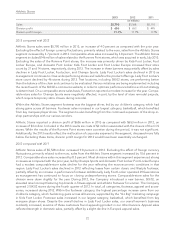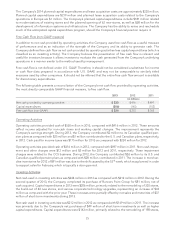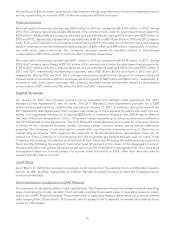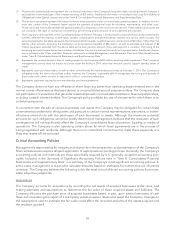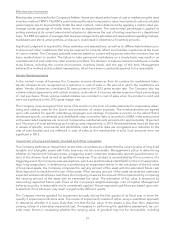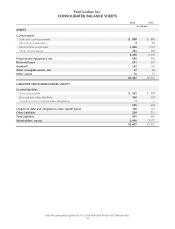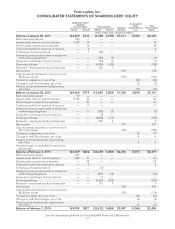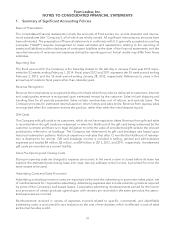Foot Locker 2013 Annual Report Download - page 53
Download and view the complete annual report
Please find page 53 of the 2013 Foot Locker annual report below. You can navigate through the pages in the report by either clicking on the pages listed below, or by using the keyword search tool below to find specific information within the annual report.
declines in stock price and market capitalization in relation to the book value of the Company and macroeco-
nomic conditions affecting retail. If, based on the results of the qualitative assessment, it is concluded that it is
not more likely than not that the fair value of a reporting unit exceeds its carrying value, additional quantitative
impairment testing is performed using a two-step test. The initial step requires that the carrying value of each
reporting unit be compared with its estimated fair value. The second step — to evaluate goodwill of a reporting
unit for impairment — is only required if the carrying value of that reporting unit exceeds its estimated fair
value. The Company used a combination of a discounted cash flow approach and market-based approach to
determine the fair value of a reporting unit. The determination of discounted cash flows of the reporting units
and assets and liabilities within the reporting units requires us to make significant estimates and assumptions.
These estimates and assumptions primarily include, but are not limited to, the discount rate, terminal growth
rates, earnings before depreciation and amortization, and capital expenditures forecasts. The market approach
requires judgment and uses one or more methods to compare the reporting unit with similar businesses, busi-
ness ownership interests, or securities that have been sold. Due to the inherent uncertainty involved in making
these estimates, actual results could differ from those estimates. We performed our annual goodwill impair-
ment assessments during 2013, using a qualitative approach. Based on the results of the impairment
assessments performed, we concluded that it is more likely than not that the fair values of our reporting units
exceeded their respective carrying values and there are no reporting units at risk of impairment.
Owned trademarks and tradenames that have been determined to have indefinite lives are not subject to
amortization but are reviewed at least annually for potential impairment. The fair values of purchased intangible
assets are estimated and compared to their carrying values. We estimate the fair value of these intangible
assets based on an income approach using the relief-from-royalty method. This methodology assumes that, in
lieu of ownership, a third party would be willing to pay a royalty in order to exploit the related benefits of these
types of assets. This approach is dependent on a number of factors, including estimates of future growth and
trends, royalty rates in the category of intellectual property, discount rates, and other variables. We base our fair
value estimates on assumptions we believe to be reasonable, but which are unpredictable and inherently uncer-
tain. Actual future results may differ from those estimates. We recognize an impairment loss when the estimated
fair value of the intangible asset is less than the carrying value. The Company’s review did not result in any
impairment charges for the year ended February 1, 2014.
Share-Based Compensation
The Company estimates the fair value of options granted using the Black-Scholes option pricing model. The
expected term of options granted is estimated using historical exercise and post-vesting employment termina-
tion patterns, which the Company believes are representative of future behavior. Changing the expected term
by one year changes the fair value by 6 to 8 percent depending if the change was an increase or decrease to
the expected term. The Company estimates the expected volatility of its common stock at the grant date using
a weighted-average of the Company’s historical volatility and implied volatility from traded options on the
Company’s common stock. A 50 basis point change in volatility would have a 1 percent change to the fair value.
The risk-free interest rate assumption is determined using the Federal Reserve nominal rates for U.S. Treasury
zero-coupon bonds with maturities similar to those of the expected term of the award being valued. The
expected dividend yield is derived from the Company’s historical experience. A 50 basis point change to the
dividend yield would change the fair value by approximately 5 percent. Share-based compensation expense is
recorded for those awards expected to vest using an estimated forfeiture rate based on its historical pre-vesting
forfeiture data, which it believes are representative of future behavior, and periodically will revise those esti-
mates in subsequent periods if actual forfeitures differ from those estimates. The Black-Scholes option pricing
valuation model requires the use of subjective assumptions. Changes in these assumptions can materially affect
the fair value of the options.
Pension and Postretirement Liabilities
The Company determines its obligations for pension and postretirement liabilities based upon assumptions related
to discount rates, expected long-term rates of return on invested plan assets, salary increases, age, and mortality,
among others. Management reviews all assumptions annually with its independent actuaries, taking into consider-
ation existing and future economic conditions and the Company’s intentions with regard to the plans.
Long-Term Rate of Return Assumption — The expected rate of return on plan assets is the long-term rate of
return expected to be earned on the plans’ assets and is recognized as a component of pension expense. The
rate is based on the plans’ weighted-average target asset allocation, as well as historical and future expected
30




